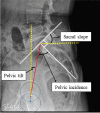Acetabular labral tear is associated with high pelvic incidence with or without femoroacetabular impingement morphology
- PMID: 35098340
- PMCID: PMC9464139
- DOI: 10.1007/s00167-022-06881-z
Acetabular labral tear is associated with high pelvic incidence with or without femoroacetabular impingement morphology
Abstract
Purpose: The aim of this study was to investigate the association between pelvic sagittal parameters and acetabular labral tears.
Methods: Three-hundred and sixty-five patients (449 hips) who underwent magnetic resonance imaging (MRI) or magnetic resonance arthrogram (MRA) for hip pain were enrolled in this study. Pelvic sagittal parameters, including the pelvic incidence, pelvic tilt, and sacral slope, were measured with a standing lumbosacral lateral radiograph. All subjects were divided into two groups according to the presence or absence of radiologic acetabular labral tears and compared. Furthermore, the two groups were divided into subgroups according to whether femoroacetabular impingement (FAI) morphology was present or not and compared.
Results: Pelvic incidence was greater in the labral tear group than in the non-labral tear group (52.3° ± 8.2° versus 47.1° ± 6.8°, p < 0.001). After accounting for potentially confounding variables, we found that higher age (odds ratio 1.04, 95% confidence interval [CI] 1.02 to 1.06, p = 0.001), FAI (odds ratio 15.11, 95% CI 7.43 to 30.75, p < 0.001), and high pelvic incidence (odds ratio 1.13, 95% CI 1.09 to 1.17, p < 0.001) were independently associated with acetabular labral tear. When only the patients without FAI (308 hips) were divided into groups with and without acetabular labral tear, we found that higher age (odds ratio 1.03, 95% CI 1.01 to 1.06, p = 0.008) and high pelvic incidence (odds ratio 1.15, 95% CI 1.11 to 1.19, p < 0.001) were independently associated with acetabular labral tear.
Conclusion: Acetabular labral tear is associated with high pelvic incidence with or without FAI morphology.
Level of evidence: III.
Keywords: Acetabular labral tear; Femoroacetabular impingement; Pelvic incidence.
© 2022. The Author(s).
Conflict of interest statement
The authors declare that they have no competing interests.
Figures
Similar articles
-
The Effect of Pelvic Incidence on Outcomes After Hip Arthroscopy for Femoroacetabular Impingement and Acetabular Labral Tears.Am J Sports Med. 2024 Mar;52(3):631-642. doi: 10.1177/03635465231219261. Epub 2024 Feb 19. Am J Sports Med. 2024. PMID: 38369972 Free PMC article.
-
Acetabular Labral Tears Are Common in Asymptomatic Contralateral Hips With Femoroacetabular Impingement.Clin Orthop Relat Res. 2019 May;477(5):974-979. doi: 10.1097/CORR.0000000000000567. Clin Orthop Relat Res. 2019. PMID: 30444756 Free PMC article.
-
Labral Reattachment in Femoroacetabular Impingement Surgery Results in Increased 10-year Survivorship Compared With Resection.Clin Orthop Relat Res. 2017 Apr;475(4):1178-1188. doi: 10.1007/s11999-016-5114-7. Clin Orthop Relat Res. 2017. PMID: 27744594 Free PMC article.
-
Femoroacetabular Impingement and Management of Labral Tears in the Athlete.Clin Sports Med. 2021 Apr;40(2):259-270. doi: 10.1016/j.csm.2020.11.003. Epub 2021 Jan 18. Clin Sports Med. 2021. PMID: 33673885 Review.
-
Controversial Issues in Arthroscopic Surgery for Femoroacetabular Impingement.Clin Orthop Surg. 2021 Dec;13(4):437-442. doi: 10.4055/cios21109. Epub 2021 Oct 15. Clin Orthop Surg. 2021. PMID: 34868490 Free PMC article. Review.
Cited by
-
Association of Chondrolabral Lesions with Ultrasound-Guided Detection of Pathological Head-Neck Contour.Diagnostics (Basel). 2023 Oct 29;13(21):3334. doi: 10.3390/diagnostics13213334. Diagnostics (Basel). 2023. PMID: 37958230 Free PMC article.
-
Spinopelvic fixation surgery in relation to the femoroacetabular impingement syndrome under the ultrasound.Eur Spine J. 2025 Jul 7. doi: 10.1007/s00586-025-09055-w. Online ahead of print. Eur Spine J. 2025. PMID: 40619521
-
The significance of the pelvic incidence measurement as a possible predictor of TKA outcome.Knee Surg Sports Traumatol Arthrosc. 2023 Aug;31(8):3106-3115. doi: 10.1007/s00167-022-07224-8. Epub 2022 Nov 10. Knee Surg Sports Traumatol Arthrosc. 2023. PMID: 36352242
-
Bone marrow aspirate concentrate adjunct for acetabular labral tear repair: a systematic review and meta-analysis.Hip Int. 2025 Jul;35(4):392-401. doi: 10.1177/11207000251337403. Epub 2025 May 15. Hip Int. 2025. PMID: 40375479 Free PMC article.
-
The Effect of Pelvic Incidence on Outcomes After Hip Arthroscopy for Femoroacetabular Impingement and Acetabular Labral Tears.Am J Sports Med. 2024 Mar;52(3):631-642. doi: 10.1177/03635465231219261. Epub 2024 Feb 19. Am J Sports Med. 2024. PMID: 38369972 Free PMC article.
References
MeSH terms
LinkOut - more resources
Full Text Sources
Medical
Research Materials



